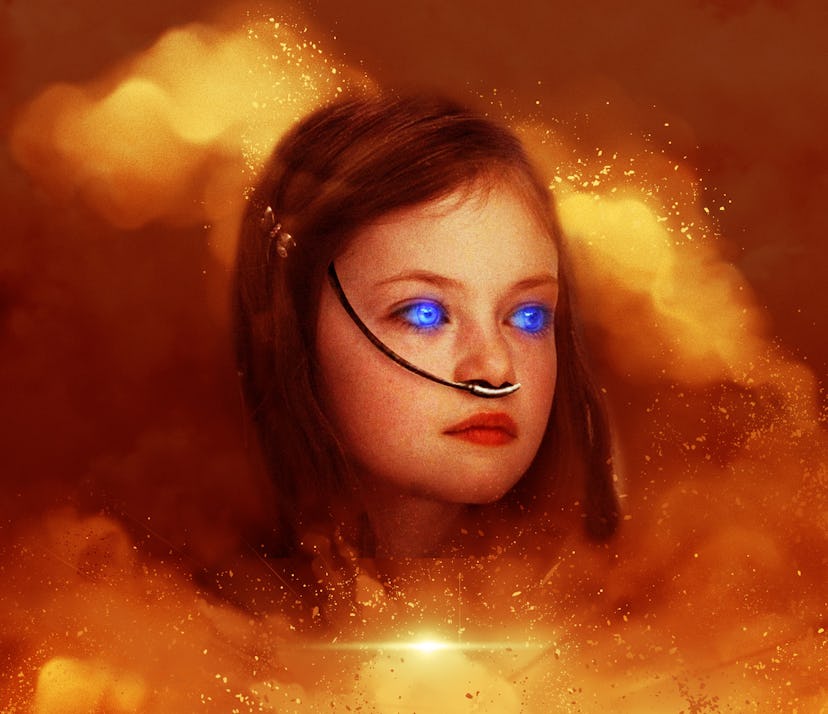Little Freaks
The Dune Renesmee We Could’ve Had
Meet Alia, the weird baby to end all weird babies.

Dune is such a cosmically weird book that it’d be impossible to make an adaptation that’s not a bit strange. Denis Villeneuve’s Dune and Dune: Part Two, while good movies on their own merits, are not nearly as weird as they should be to capture the true essence of Frank Herbert’s story. For instance, whenever Timothée Chalamet or Zendaya wears a stillsuit (you know, those leathery onesies the Fremen don in the desert), the suits should be recycling not just sweat and spit, as the film explains, but urine, too. To rephrase, they should be drinking pee.
I could enumerate several more gross, baffling, and borderline-inscrutable plot details that the movies elide, but let’s skip ahead to the big one: the weird baby.
In Dune: Part Two, Lady Jessica (Rebecca Ferguson) is pregnant with a telepathic, all-knowing fetus, who she regularly chats with. This is definitely odd, but it only grazes the depth of oddness we could’ve had. We could have had a Dune Renesmee.
Renesmee is, of course, the baby from Twilight: Breaking Dawn. Half-human, half-vampire, and all uncanny valley, the child of Bella and Edward is born with an eerily expressive face. Her motor control skills are set to expert, and she matures at a biologically impossible rate. The result is a baby who looks “weirder and scarier-looking than any vampire,” as The Guardian memorably put it.
In Herbert’s universe, the freaky baby is even weirder. Paul’s little sister, Alia, absorbs a mind-altering substance while in her mother’s womb and is quickly transformed from normal fetus to unholy abomination: a child called Alia-the-Strange-One, a baby who talks not only like an adult (childish lisp notwithstanding), but with access to the knowledge of dozens of generations of Bene Gesserit space witches. At around age 4, she’s running around slaughtering soldiers with a knife; she’s the one who does in the villainous Baron Harkonnen, not Paul. A killer witch toddler! A dyed-in-the-wool freak.
As director, Villeneuve chose to keep Alia (played in Part Two as an adult in a brief flash-forward by Anya Taylor-Joy) womb-side as a way to speed up the plot and to better illustrate why she’s so weird for the next movie.
I have a different theory: They knew they had a potential Renesmee situation on their hands. There is simply no way to render a murderous 4-year-old that doesn’t look absolutely batsh*t, because a murderous 4-year-old — let alone one who holds herself like a fully-grown woman, knows the universe’s deepest truths, and delivers requests like “make him afraid some more” — is absolutely batsh*t.
But how glorious it would’ve been! Another weird baby for the ages, destined to join cinema’s long legacy of grotesque infants: Dawn of the Dead’s My Little Zombie, Trainspotting’s “Look Ma, I Can Turn My Head All The Way Around” model, Benjamin Button’s What’s Old Is New Again infant, Eraserhead’s… whatever that was, and, of course, Renesmee.
These littlest of freaks serve an important purpose in the cultural consciousness. As much as we may try to push some facts away, they have a habit of bubbling back up, and there’s an inconvenient truth (no Al Gore) that Alia and her fellow abominations convey: Babies are kind of weird. They’re always secreting something — drool, vomit, pee, poop — and their appearances are uncanny reflections of our own.
Think of what we’ve lost: the chance to see Timothée Chalamet discuss battle tactics with a near-omniscient 2-year-old; a scene where Christopher Walken and his whole royal court are bamboozled by a blue-eyed little weirdo. In future adaptations — and there will be more, despite the “unadaptable” source material — I want an Alia for every movie, a Renesmee behind-the-scenes featurette in every DVD.